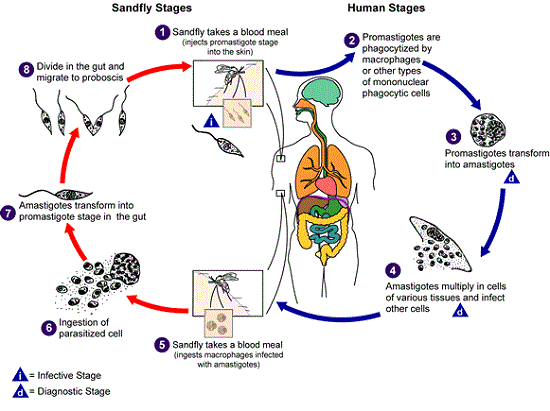Leishmania tropica complex - Life Cycle, Pathogenesis, Pathology, Host Immunity, Epidemiology, Reservoir
Life Cycle of Leishmania tropica complex
The life cycle of the Leishmania tropica complex is completed in two different hosts:
Man or other mammals- the amastigote form
Sandfly of genus Phlebotomus and Lutzomyia – the promastigote form
These mammals include dogs, rodents, foxes, etc.
Leishmania tropica Complex is transmitted to man and other vertebrates by the bite of a blood-sucking female sandfly
During the blood meal, the promastigotes are transmitted from the saliva of the vector to the host’s skin
the promastigotes are then immediately phagocytosed by the host macrophages where they transform into amastigotes
the newly formed Leishmania tropica Complex amastigotes undergo binary fission to produce a large number of amastigotes which continue to divide inside the enlarged macrophages
the infected macrophages rupture to release a large number of amastigotes (around 200 in number) into the host body circulation
the parasites then reside in monocytes, polymorphonuclear leucocytes as well as in the endothelial cells of the capillaries of the skin but do not invade the internal organs or peripheral blood
if the infected mammal host (including man) is bitten by a female sand-fly during a blood meal, the free amastigotes are also taken up with the host blood
in the midgut of the sand-fly, within 72 hours, the amastigotes are transformed into promastigotes
the morphological transformation takes place through a series of flagellated intermediate promastigote forms to flagellated promastigotes
the promastigotes undergo binary fission, produce a large number of parasites, and completely fill the lumen of the gut
after 6-9 days, the promastigotes travel to the sandfly's pharynx and buccal cavity from the mid-gut
bite from the infected sand-fly to mammals (including humans) during its blood meal transmits the infection and the life cycle of Leishmania tropica Complex is continued

Figure: L. tropica Complex life-cycle (Source: CDC)
Pathogenesis, Pathology of Leishmania tropica complex
A bite from a female sandfly during a blood meal deposits the promastigotes, present in the vector’s saliva/mouthparts, in the skin. The newly introduced promastigotes are phagocytosed by host macrophages where they transform into amastigotes.
The key pathological lesions of Leishmania tropica Complex infection are papules and ulcers, which are the common forms of cutaneous leishmaniasis.
Papule
papule occurs in the early stage of the disease
caused by the multiplication of macrophages that harbor a large number of amastigotes (up to 200 amastigotes in each infected macrophage)
in the lesion, host immune cells such as inflammatory cells, plasma cells, and lymphocytes can also be found
in untreated cases, the papules get enlarged, necrotize, and eventually ulcerate
Ulcer
ulcer may be single or multiple in number
occurs in mainly exposed parts of the body such as the face and extremities but is mainly absent from the areas where the epidermis is thick such as the palm, sole, or the scalp
the ulcer may persist from weeks to months
with the healing of the ulcer, a flat atrophic scar is formed
these ulcers leave life-long scars, serious disability, or social stigma
number of macrophages, lymphocytes, and plasma cells also decreases as the lesion heal
Host Immunity of Leishmania tropica complex
the host immunity in response to Leishmania tropica Complex includes profound development of cell-mediated hypersensitivity reaction
humoral immunity is not involved in defense against cutaneous leishmaniasis
similar to leprosy, cutaneous leishmaniasis is immunologically considered a polar disease
the two polar forms are
diffuse cutaneous leishmaniasis
eishmaniasis recidivans
the cell-mediated immunity (CMI) in response to cutaneous leishmaniasis is similar to that of lepromatous leprosy
the tuberculoid leprosy is analogous to leishmaniasis recidivans
cases of re-infection by the same species of Leishmania tropica Complex are low as after recovery, the resistance to the disease is very high
Epidemiology of Leishmania tropica complex
three forms of Old World cutaneous leishmaniasis are recognized
epidemilogically, cutaneous leishmaniasis occurs in Iran, Afghanistan, Brazil, Syria, India, Peru, Saudi Arabia
Reservoir, Source of Leishmania tropica complex
transmission of Leishmania tropica Complex occurs due to the bite of infected female sand-fly
the reservoir, source of Leishmania tropica Complex is the infected man or canines like the dog
cutaneous leishmaniasis affects all age groups, especially young adults, infants, and adolescents